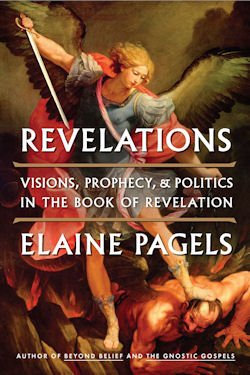
|
Posted March 22, 2012
Book: Revelations: Visions, Prophecy, and Politics in the Book of Revelation Author: Elaine Pagels Viking. New York. 2012, pp. 246 An Excerpt from the Jacket:
To give its original context, Pagels returns to 66 C.E. In the waning days of the Roman Empire, militant Jews in Jerusalem had waged an all-out war against Rome's occupation of Judea, and their defeat resulted in the desecration of the Great Temple in Jerusalem. In the aftermath of that war, John of Patmos, a Jewish prophet and follower of Jesus wrote the Book of Revelation, prophesying God's judgment on the pagan empire that devastated and dominated his people. Soon after, Christians fearing arrest and execution championed John's prophecies as offering hope for deliverance from evil. Others seized on the Book of Revelation as a weapon against heretics and infidels of all kinds; the book has fascinated saints, mystics, and artists to this day. Even after John's prophecies seemed disproven --- instead of being destroyed, Rome became a Christian empire --- those who lived John's visions refused to discard them and instead reinterpreted them --- as Christians have done for two thousand years. Throughout the centuries, readers and artists have taken John's Book of Revelation seriously without taking it literally, as each generation sees its own conflicts, sufferings, and hopes reflected in John's powerful images of cosmic war and divine victory. An Excerpt from the Book Yet John's Book of Revelation appeals not only to fear but also to hope. As John tells how the chaotic events of the world are finally set right by divine judgment, those who engage his visions often see them offering meaning --- moral meaning --- in times of suffering or apparently random catastrophe. Many poets, artists, and preachers who engage these prophecies claim to have found in them the promise, famously repeated by Martin Luther King Jr., that "the arc of the moral universe is long, but it bends toward justice." Finally, too, this worst of all nightmares ends not in terror but in a glorious new world, radiant with the light of God's presence, flowing with the water of life, abounding in joy and delight. Whether one sees in John's visions the destruction of the whole world or the dark tunnel that propels each of us toward our own death, his final vision suggests that even after the worst we can imagine has happened, we may find the astonishing gift of new life. Whether one shares that conviction, few readers miss seeing how these visions offer consolation and that most necessary of divine gifts ---- hope. But we have seen that the story of this book moves beyond its own pages to include the church leaders who made it the final book in the New Testament canon, which they then declared closed and scriptural revelation complete. After Athanasius sought to censor all other "revelations" and to silence all whose views differed from the orthodox consensus, his successors worked hard to make sure that Christians could not read "any books except the common catholic books." Table of Contents: John's revelation: challenging the evil empire, Rome Visions of heaven and hell: from Ezekiel and John of Patmos to Paul Other revelations: heresy or illumination? Confronting persecution: how the Jews and Christians separated politics from religion Constantine's conversion: how John's revelation became part of the Bible Conclusion |
|
